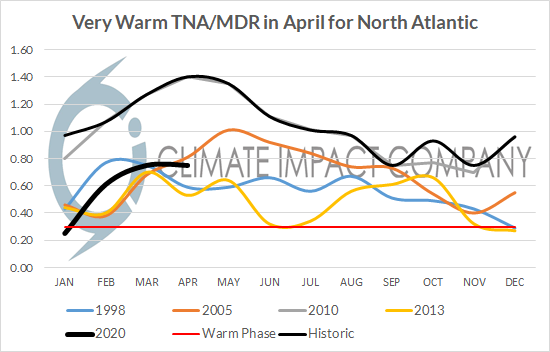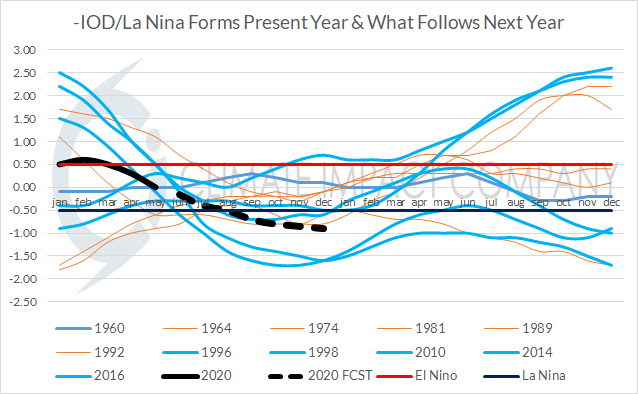
Unique: Very Warm Gulf of Mexico and Tropical North Atlantic Ahead of the 2020 Tropical Cyclone Season
04/19/2020, 9:49 am EDT
Indian Ocean Dipole (-IOD) AND La Nina Increases Risk of Stronger La Nina Climate AND La Nina Lingering Into Next Year
05/25/2020, 10:15 am EDT
Fig. 1: Precipitation rate anomalies since Jan. 1st identify a wet pattern across central and east Brazil while southeast Brazil is dry.

Fig. 2: The prevailing upper air pattern since Jan. 1st identifies a persistent upper trough east of Uruguay while high pressure ridging is evident across the equatorial region. Trade winds blowing onshore northeast Brazil brought above normal rainfall while a north to west land breeze on the back side of the upper trough in Southeast Brazil was a dry land breeze.
Discussion: Dr. Sanjiv Kumar at the Auburn University School of Forestry and Wildlife Services with Matt Newman of the Boulder, Colorado-based NOAA Earth System Research Laboratory, or ESRL, and his colleagues Yan Wang and Ben Livneh, also at the University of Colorado Boulder published research in the American Meteorological Society Journal of Climate in 2019 on how deep layer soil moisture presence is the catalyst to flash drought if followed by a period of dry climate coupled with anomalous heat. The regime described occurred over the Parana River Basin in Southeast Brazil to Northeast Argentina in 2020…developing deep layer soil moisture deficit strengthened by late season dryness and heat across Southeast Brazil.
The synoptic climate details enabling the dry pattern in Southeast Brazil (Fig. 1) were caused by two regimes…a moist northeast trade wind flow into Northeast Brazil and reaching Central Brazil caused by the negative phase of the Atlantic meridional mode (-AMM) and by the prevailing (dry) land breeze across Southeast Brazil trailing a persistent deep upper trough east of Uruguay (Fig. 2). Gradually (dating back to late last year) a deep layer (10-200 CM) soil moisture regime developed in Southeast Brazil (Fig. 3-5) enabling late summer/early autumn dry climate and anomalous heat to quickly accelerate drought (and rapidly lower Parana River levels).



Fig. 3-5: Long-term soil moisture deficit appeared in Southeast Brazil (across Parana River) in the 5-month 10-200 CM soil moisture anomaly deficit analysis provided by NCDC/PSD. The deep layer soil moisture deficit expanded in 2020 and increased risk of “flash drought” if late summer dryness and anomalous heat developed.
Auburn University research: Sanjiv Kumar and his climate research associates identified deep layer soil moisture deficit as a catalyst to flash drought in a document published in the Journal of Climate last year.
https://ocm.auburn.edu/newsroom/news_articles/2019/10/030958-research-long-term-drought.php
![Climate-Impact-Company-logo-sm[1]](https://climateimpactcompany.com/wp-content/uploads/2023/08/Climate-Impact-Company-logo-sm1.png)